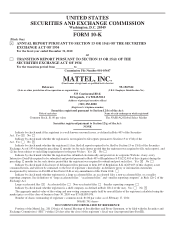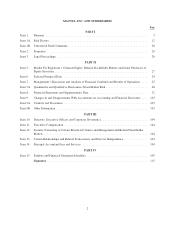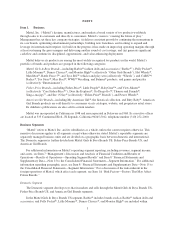Mattel 2010 Annual Report Download - page 17
Download and view the complete annual report
Please find page 17 of the 2010 Mattel annual report below. You can navigate through the pages in the report by either clicking on the pages listed below, or by using the keyword search tool below to find specific information within the annual report.purchase and sale of inventory, and other intercompany transactions denominated in foreign currencies. These
contracts generally have maturity dates of up to 18 months. In addition, Mattel manages its exposure to currency
exchange rate fluctuations through the selection of currencies used for international borrowings. Mattel does not
trade in financial instruments for speculative purposes.
For additional information regarding foreign currency contracts, see “International Segment” above,
Item 7A “Quantitative and Qualitative Disclosures About Market Risk” and Item 8 “Financial Statements and
Supplementary Data—Note 11 to the Consolidated Financial Statements—Derivative Instruments.”
Seasonal Financing
See Item 8 “Financial Statements and Supplementary Data—Note 7 to the Consolidated Financial
Statements—Seasonal Financing and Debt.”
Government Regulations and Environmental Quality
Mattel’s toy products sold in the US are subject to the provisions of the Consumer Product Safety Act, the
Federal Hazardous Substances Act, and the Consumer Product Safety Improvement Act of 2008, and may also be
subject to the requirements of the Flammable Fabrics Act or the Food, Drug, and Cosmetics Act, and the
regulations promulgated pursuant to such statutes. These statutes ban from the market consumer products that fail
to comply with applicable product safety regulations. The Consumer Product Safety Commission (“CPSC”) may
require the recall, repurchase, replacement, or repair of any such banned products or products that otherwise
create a substantial risk of injury and may seek penalties for regulatory noncompliance under certain
circumstances. Similar laws exist in some states and in many international markets.
Mattel maintains a quality control program to help ensure compliance with various US federal, state, and
applicable foreign product safety requirements. Nonetheless, Mattel has experienced, and may in the future
experience, issues in products that result in recalls, withdrawals, or replacements of products. A product recall
could have a material adverse effect on Mattel’s results of operations and financial condition, depending on the
product affected by the recall and the extent of the recall efforts required. A product recall could also negatively
affect Mattel’s reputation and the sales of other Mattel products. See Item 1A “Risk Factors—Factors That May
Affect Future Results” and Item 8 “Financial Statements and Supplementary Data—Note 4 to the Consolidated
Financial Statements—Product Recalls and Withdrawals.”
Mattel’s advertising is subject to the Federal Trade Commission Act, The Children’s Television Act of
1990, the rules and regulations promulgated by the Federal Trade Commission, and the Federal Communications
Commission, as well as laws of certain countries that regulate advertising and advertising to children. In addition,
Mattel’s websites that are directed towards children are subject to the Children’s Online Privacy Protection Act
of 1998. Mattel is subject to various other federal, state, local and international laws and regulations applicable to
its business. Mattel believes that it is in substantial compliance with these laws and regulations.
Mattel’s worldwide operations are subject to the requirements of various environmental laws and
regulations in the jurisdictions where those operations are located. Mattel believes that it is in substantial
compliance with those laws and regulations. Mattel’s operations are from time to time the subject of
investigations, conferences, discussions, and negotiations with various federal, state and local environmental
agencies within and outside the United States with respect to the discharge or cleanup of hazardous waste. Mattel
is not aware of any material cleanup liabilities.
Employees
The total number of persons employed by Mattel and its subsidiaries at any one time varies because of the
seasonal nature of its manufacturing operations. Mattel’s total number of employees increased from
approximately 27,000 at December 31, 2009 to approximately 31,000 at December 31, 2010 due to increased
staffing levels at manufacturing facilities, resulting from higher production levels at the end of 2010 to support
point of sale momentum and improve customer service levels.
9
























